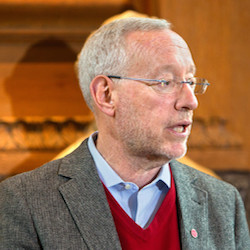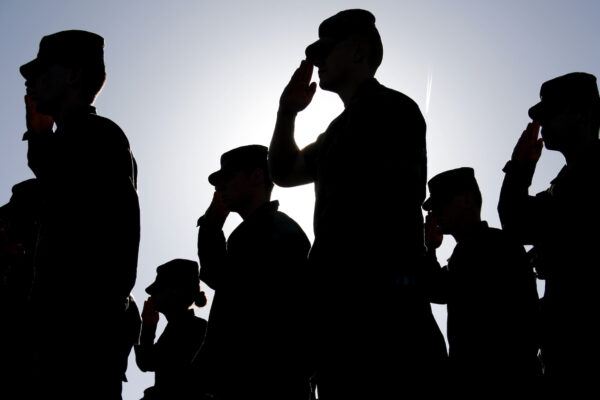Cornell Provost Michael I. Kotlikoff on how—and why—the university is attempting to quadruple its enrollment of undergraduate veterans by 2020.
Currently, fewer than two out of every 1,000 undergraduate students enrolled in Ivy League colleges have served in the U.S. military. I think it is safe to say that there are far more Ivy undergrads who have lived in Paris than on Parris Island.
Between now and 2020, Cornell hopes to significantly increase the number of undergraduate military veterans enrolled at the university, an additional step to better engage students who have served in uniform, through a specific recruiting campaign, with a goal of quadrupling undergraduate veteran enrollment by 2020. Frankly, far too few veterans are enrolled in our elite undergraduate institutions, and we must all do a better job at reaching out to students who have served this country and who have much to offer undergraduate communities. For Cornell, this goal aligns with the university’s ongoing commitment to Ezra Cornell’s vision to “found an institution where any person can find instruction in any study.”
As New York’s land-grant institution, Cornell has a long history of welcoming and supporting veterans. Recently, generous contributions have enhanced our ability to recruit these students and to help ensure their success. Thanks to these gifts and to dedicated Cornell student veterans Seamus Murphy ’16 (U.S. Army) and David Outlaw Jr. ’17 (U.S. Navy), as well as other student veterans who formed the Cornell Undergraduate Veterans Association in 2015, our undergraduate student veterans have an official and visible presence on campus.
Through our engagement with this association, university leaders, including me, are gaining a better understanding about the challenges that veterans, many of whom enlisted immediately after high school, face in applying to institutions like Cornell. The first reaction is “I don’t belong there,” which encapsulates our challenge, both in communicating the fact that many fellow veterans have thrived at Cornell and in welcoming veterans into the university environment. I have also seen how their varied backgrounds and considerable life and work experiences can contribute to campus life and enhance the diversity of our student body.

In order to work toward this goal, the university has taken several important steps.
First, we are stepping up our recruiting efforts. Cornell is a founding partner of the VetLink program through Service to School, which offers veterans application counseling at no cost. VetLink identifies competitive student-veteran candidates for our admissions office, helping to pinpoint veterans for whom Cornell is a good fit and showing them how to best describe their life experiences in their undergraduate applications. To date, Cornell has admitted 13 veterans who were identified by VetLink. Our goal is to significantly increase that number. We are also engaging our undergraduate and graduate/professional student veterans as recruiting volunteers, spreading the word at their bases, junior colleges and in their communities, and Cornell has signed a MOU with the Department of Defense which will enable us to have an admissions recruiting presence on U.S. military bases.
Second, in considering how our financial aid process can better administer the Post-9/11 GI Bill Yellow Ribbon Program (an education benefit program for military veterans designed specifically for students attending private colleges and universities through which both the university and the Department of Veterans Affairs contribute to the cost of education) and to help veteran undergraduates access their Veterans Affairs benefits, we have implemented a number of changes in how we support students. These changes include designating two financial aid staff to specifically serve student veterans and answer all veteran-related financial aid questions; improving data sharing and collaboration among registrar, financial aid and bursar staff to accelerate veteran-benefit certifications; and implementing an annual survey of Yellow Ribbon recipients to improve our understanding of veteran student issues such as benefit usage, health insurance, living situations and federal aid.
Third, to make these improvements available to more veterans, Cornell’s Military Community website provides numerous resources for veteran students, faculty and staff. And our Veterans at Cornell admissions website helps applicants learn about Cornell and the benefits we provide to student veterans. Cornell undergraduate admissions officials also continue to improve and expand veteran initiatives. For example, the Cornell Undergraduate Veterans Association and our admissions office contact each admitted student veteran to help ensure a successful transition to life as a Cornell student.
Finally, we are enhancing the on-campus experience for enrolled veterans, who are usually older students and can have challenges in fully integrating within undergraduate campus life. A new veterans’ advocate position and office will provide support, advocacy, programming and referrals for our veteran undergraduates.
As a service to veterans who are preparing to enter a higher education environment, Cornell hosts the Warrior-Scholar Project, which is an “academic boot camp” of reading and writing classes designed to assist veterans who are deciding whether they want to enroll in a college or university. Thus far, two Warrior Scholar Project veterans are enrolled at Cornell.
Cornell is taking these steps to engage, attract and retain undergraduate student veterans as part of our unwavering effort to embrace our founding principles. Our 2020 veterans enrollment goal is just the latest manifestation of this enduring, 150-plus year heritage.
If you have any questions or comments about this blog post, please contact us.


